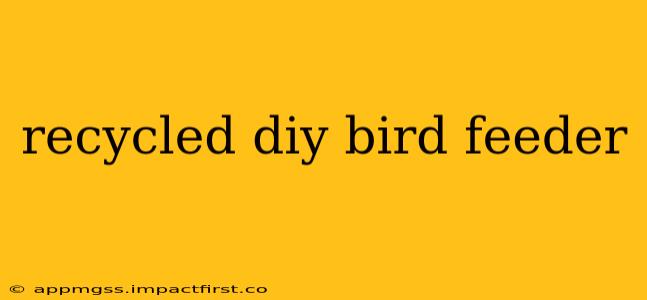Are you an avid birdwatcher? Do you love crafting? Then combining these passions with environmentally friendly practices by making a recycled DIY bird feeder is a perfect project! This guide provides creative ideas and detailed instructions to build your own unique bird feeder using recycled materials, attracting a vibrant array of birds to your garden while minimizing waste. We'll also explore frequently asked questions about creating and maintaining these delightful feeders.
What materials can I use to make a recycled bird feeder?
The beauty of recycled bird feeders lies in their adaptability. Almost any sturdy, clean, and non-toxic recycled material can be repurposed. Popular choices include:
- Plastic bottles: These are readily available and easily manipulated. Cuttings can be easily made to create feeding ports.
- Milk cartons: After thorough cleaning and drying, milk cartons provide a sturdy base for a simple feeder.
- Cans: Cleaned and appropriately modified metal cans (ensure sharp edges are smoothed) can also work well. Consider using cans with a wider opening.
- Cardboard tubes: Toilet paper rolls or paper towel tubes, when bundled and secured, can create unique feeder designs. Remember to protect them from the elements!
- Wooden pallets: Sections of sturdy, untreated wood pallets can be crafted into more elaborate feeders. Ensure all splinters are removed and the wood is properly treated for outdoor use.
- Plastic containers: Yogurt containers, margarine tubs, or other clean plastic containers can be adapted into small, charming feeders.
Remember to always prioritize safety. Remove any sharp edges or potentially hazardous parts before construction.
How do I make a bird feeder from a plastic bottle?
This is one of the easiest and most popular methods. Here's a simple guide:
- Clean and dry: Thoroughly clean and dry your chosen plastic bottle. Remove labels completely.
- Create feeding ports: Use a sharp knife or scissors (adult supervision needed) to cut several small holes in the sides of the bottle. These should be large enough for birds to access the seed but small enough to prevent the seed from spilling out easily.
- Add perches: Optional: Small twigs or dowels can be inserted near the feeding ports to provide birds with perches.
- Fill with seed: Add your birdseed of choice. Sunflower seeds, nyjer seeds, and millet are popular choices.
- Hang it up: Punch a hole near the bottle's cap, thread a string or wire through it, and hang the feeder from a tree branch or a sturdy hook.
What kind of birdseed is best for a DIY feeder?
The type of birdseed you use will attract different species. Research the common birds in your area to determine their preferred food sources. A mix of seeds is often the best approach. Consider:
- Sunflower seeds: A favorite among many bird species.
- Nyjer seeds: Attracts finches and other small birds.
- Millet: A less expensive option, popular with various seed-eating birds.
- Suet: High-energy food ideal for winter feeding. This can be added to mesh feeders.
How do I prevent squirrels from raiding my bird feeder?
Squirrels are notorious for stealing birdseed! Here are a few strategies:
- Use squirrel-resistant feeders: These feeders are designed with features that prevent squirrels from accessing the seed.
- Place feeders strategically: Hang feeders in locations that are difficult for squirrels to reach, such as far from branches or trees they can easily jump from.
- Use a baffle: A baffle is a device placed above the feeder to prevent squirrels from climbing up the supporting pole or string.
How often should I clean my DIY bird feeder?
Cleaning your bird feeder regularly is crucial for maintaining the health of the birds. Clean your feeder at least once a month, or more often if it becomes soiled with droppings or mold. Use warm, soapy water and thoroughly rinse before refilling with seed.
Are there any safety concerns with DIY bird feeders?
Yes, always exercise caution when constructing your feeder:
- Sharp edges: Make sure to smooth out any sharp edges from cutting or repurposing materials.
- Materials: Use only non-toxic materials. Avoid using materials that have been treated with chemicals or pesticides.
- Placement: Place feeders in a safe location, away from windows and potential hazards.
By following these guidelines and letting your creativity flow, you can create a beautiful and functional recycled DIY bird feeder that will bring joy to you and provide a vital food source for your local avian friends. Remember to adapt the designs to the materials you have available and to always prioritize the safety and well-being of the birds.
